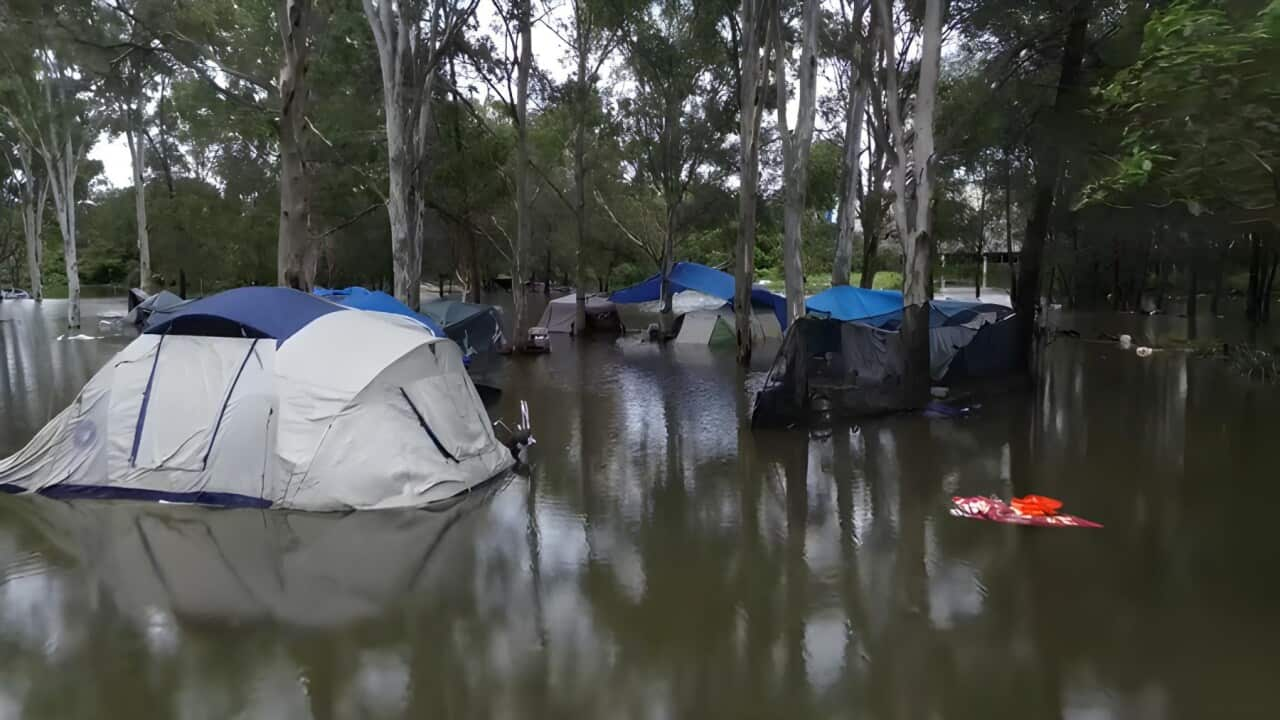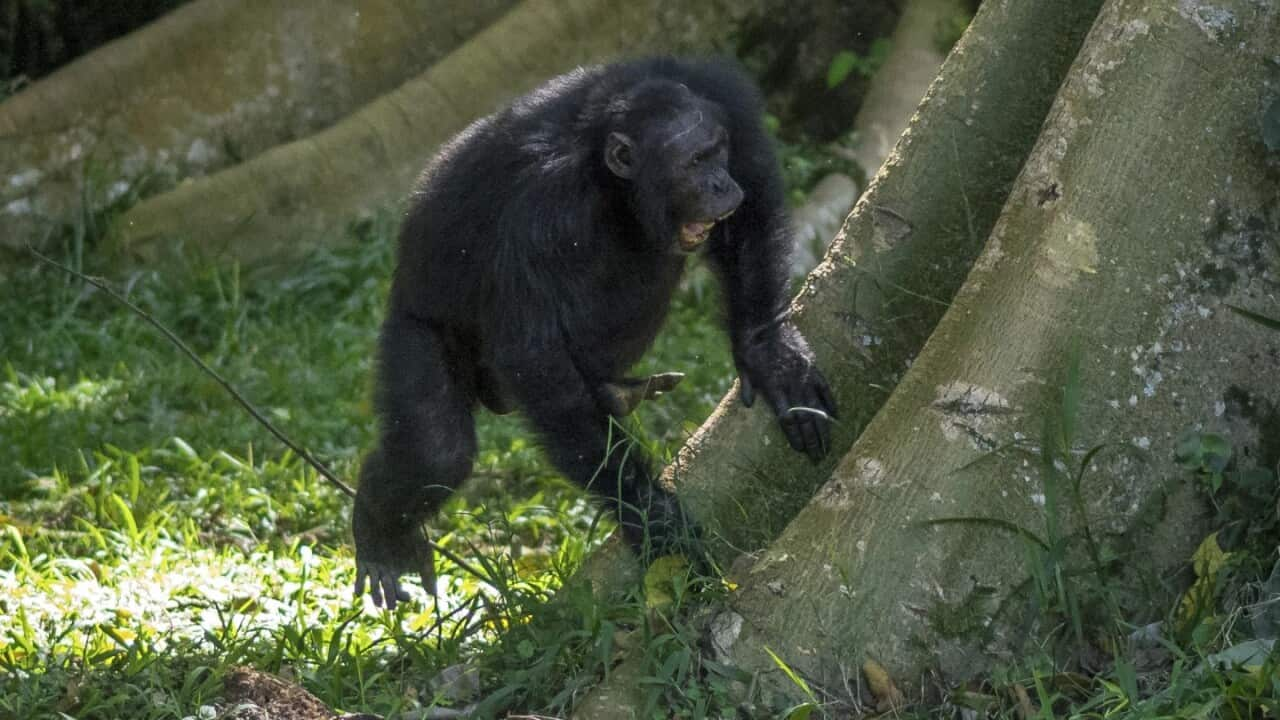TRANSCRIPT
In south-east Queensland, the City of Logan is battling a housing and homelessness crisis...
In several public parks, encampments of rough sleepers known as 'tent cities' have exploded in size over the past 18 months.
One of the largest, in the suburb of Beenleigh, was inundated when rivers rose rapidly on Sunday night as ex-Tropical Cyclone Alfred dumped heavy rain across the region.
Mick Pignat and his dog Red have been living at the park for over a year.
He told SBS News the tent city's residents had been at the mercy of the elements.
“It hit pretty hard. The winds were the worst and with the rain. We just sat there trying to keep it all down, keep tents down. Keep our roofs on, so we can get covered and keep out of the wet. But uh yeah, it came down and uh cops kept coming and driving in all the time, checking we're all right and most people left. You know, like people flooded out over there, they left. Um they went to a shelter. They asked me if I want to go show I said 'nah', I'll stick it out. And then I'll stay there with my house and my dog. So yeah, and uh yeah, it got up pretty high. We thought it was gonna I thought it was gonna be floating by morning, but uh no, it wasn't so we made it. It got up to that gum tree out the back.”
The nearby Albert River rose rapidly on Sunday night, as Alfred battered the region with winds up to 100 kph and 24-hour rainfall totals up to 400 millimetres in parts of South East Queensland.
Mick chose to stay - but dozens left in a hurry.
“They went out quick. Um so as the water started uh hitting that creek uh down the bottom there uh they all started going out and they all moved out. Yeah. They Yeah. they went up the shelters. The SES and that came through about 3 days ago and I gave us emergency packs with radios in them. Unfortunately mine fell and found a bucket of water. The last four or five days has just been horrendous. You know I haven't been anywhere basically just sitting here trying to protect me home you know what I got for me and my dog so and I've had people come in staying in there cos I had nowhere else to go and they were rained out as well and tents were blown away. So I've got a few people staying with me at the moment. But yeah, part of that yeah. It's you put up with what you can. You battle on.”
He narrowly avoided the reality now facing many of his neighbours.
Their tents, belongings and critical identification documents have been destroyed.
“Everyone in them tents lost pretty much most of their belongings. Some of them got a little bit in in trolleys and pushed out where they could and carried where they could. But everything else is left there. We didn't know if it was going to come that far up. Considering we live homeless you know we're here we're trying to find somewhere to go. Somewhere to live and it's a hard time at the moment and uh yeah and then you lose what you have. You know what I mean? It sucks... it really does”
A local homelessness service, YFS, says the park had around 37 campsites with three to four people in each.
The number of sites left standing after the flood is 11.
Camila Aldred, Client Service Manager at YFS, visited the site after the flooding.
“It's just shocking that we still have people living in those circumstances. I personally was shocked. Um I had like an intellectual understanding of what I was going to see, but when I actually saw it, I was really sort of sad and disappointed that we'd as a community, as a Logan community and as Australia, the lucky country, had allowed it to happen.”
YFS worked with emergency services to warn rough sleepers in the area to evacuate, but YFS CEO Christopher John says a major challenge was getting those in the park to take up offers of temporary accommodation or to go to an evacuation centre.
“I think part of the challenge also when the cyclone was approaching is that it was difficult to get the message across because it was a sunny day and people just not quite understanding or not getting all the news and but I think if there's one benefit out of this is that we did eventually have some people take up offer in that support. And those that have actually gone into a hotel accommodation over that period are now working with us to sort of get into other more stable accommodation moving forward. That's still very difficult in Logan and the affordability and the challenge around that.”
According to YFS and the Logan Zero campaign, which tracks homelessness data, the number of rough sleepers in the Logan City Council area has risen sharply since the start of the COVID pandemic, up 277 per cent.
Median rents skyrocketed by $200 since 2021.
Logan City Council Mayor Jon Raven says his local government area is the fastest growing in the state... and that the issue of housing and homelessness there is complex and challenging.
“We're the fastest-growing city in the state. It's really complicated and challenging. My heart goes out to the people who are legitimately trying to find housing and just can't. we would take a compassionate approach where as long as people were looking for housing.”
Camila Aldred from YFS also says the situation is very complex, with working families and young people impacted by the housing and cost of living crisis.
“We have people who are working who are living in parks and in their cars. Young people are disproportionately represented in the homeless population. I guess part of that relates to their low income if they're on CentreLink payments and their lack of rental history, which doesn't make them an attractive tenant when they're competing against people other people. We often have, up to 40 people competing for the one property so it's increasingly difficult.”
A new approach has been announced by Brisbane's Lord Mayor, who says the council will move to clear out encampments after realising many people living in tents have refused offers of crisis accommodation.
“We will give 24 hours notice once we have a chance to talk to each individual, that the tents will be removed, and we will be removing those tents. The aim then is to get them into crisis accomodation that's available as we speak or to link them up with the support that's available. People are refusing homes or accomodation because it's not in the right suburb that they want to be in. We've moved on since two years ago. Two years ago there was no crisis accomodation available at all, it was full. There were no homes available at all. There are now homes available and there is crisis accomodation available, so we're in a different situation, it requires a different response.”
Karen Walsh, CEO of Micah Projects - a not for profit that provides housing support - is cautiously supportive of the move.]
“We can't rely on tents as a way of resolving homelessness. It creates a whole other level of disadvantage of problems that come with it in for both the community's safety and personal safety. However this isn't something we should be blaming individuals for, this is a structural issue.”
For rough sleepers impacted by flooding, Logan Mayor Jon Raven says another risk also looms.
“Floodwater is not clean. It's got sewer overflow into it. And the septic tank from the toilets that are in that park, that's also overflowed. So at the moment, we've got it fenced. It could be months before we can actually restore that site.”
Uncertainty now, for those who call tent cities home.













